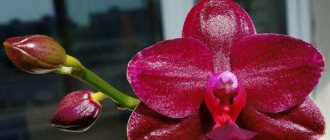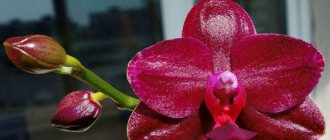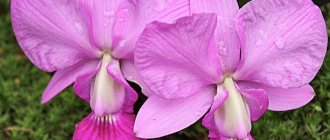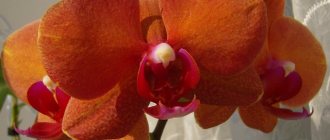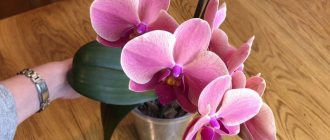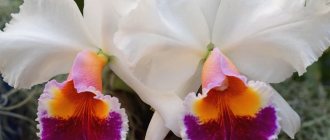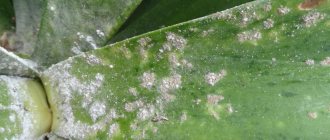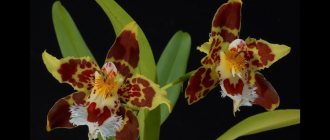Orchids take root well indoors. Pictures and photographs of such indoor plants can be found in most publications devoted to indoor floriculture. The most commonly grown orchids at home are those belonging to the Phalaenopsis white species. They are characterized by fairly high unpretentiousness and can be easily grown even by novice gardeners.
White color is always relevant, but in recent years the popularity of other colors of indoor flowers has been growing. Quite often you can see “Phalaenopsis white” and “Phalaenopsis purple” in photographs and pictures. This unusual purple orchid is increasingly appearing on the windowsills of flower growers in our country.
General information
“Phalaenopsis violet” is known to many under the name “Phalaenopsis violation”. The name of the houseplant comes from the Latin "Phalaenopsis violacea" . Photos of this epiphytic herbaceous plant of the orchid family fascinate with their beauty. “Phalaenopsis violet” has an unusual color, but does not have an established Russian name. In Russian-language sources, the indoor plant of this species is most often called the purple orchid; flower growers also use the scientific name.
A feature of the species status is the inaccurate knowledge of the origin of this plant. Many believe that the purple Phalaenopsis is a natural variation of Phalaenopsis bellina. Other authors describe the similarity in the photo with “Phalaenopsis violacea”. A miniature version of a monopodial deciduous epiphyte can be clearly seen in the photograph. The plant has a solid peduncle that can bend in a zigzag manner and bear a small number of flowers.
The flowers of the plant are characterized by a waxy appearance and have a pleasant, pronounced aroma that can be compared with the smell of water lilies, as well as freesia or bergamot. The diameter of the flowers does not exceed 6 cm. The petal part of the flowers is clearly visible in the photograph of “Phalaenopsis violet” and has an elliptical or oval-elliptical shape. The flowering plant is quite common throughout the year, and the mass flowering stage begins in spring and continues until autumn . A variety of color options are presented in the photographs of this plant.
"Phalaenopsis violet" has fleshy, elliptical or oblong-elliptical, sharp or blunt leaves. Mature plants have powerful leaves, the length of which can exceed 25 cm and the width reaches 12 cm.
Manifold
Almost all major orchid families contain species whose flowers are purple.
Here are some of them.
Purple Phalaenopsis orchid. This is the most common type, perfectly adapted for living at home. It survives well in various temperature ranges. The dormant period of this plant is not pronounced. Flowers look like a butterfly. Shades of violet and lilac, and there are also colors from mauve to dark purple. There is practically no smell. Phalaenopsis also develop an aerial root system, which allows them to obtain moisture from the air. The most popular representatives of this variety are: Phalaenopsis Schiller, Phalaenopsis Luddeman and Phalaenopsis pink.
Vanda Orchid. This orchid is called the bearded orchid because in nature it develops a huge root system that resembles a beard. At home, the flower also grows long aerial roots. This plant lives well on a block and does not need soil. In addition, it can be mounted in a special flower pot or in a glass vase. The stems of the presented orchid are cylindrical; many leaves grow on them. Flowers can be of different sizes and have a pleasant aroma. The most common types of purple color: Vanda Sander, Vanda Rothschild.
Dendrobium. Quite a compact orchid. Lilac Dendrobium orchids are both epiphytic and lithophytic flowers. The epiphytic form predominates. In nature, such plants attach themselves to trees, their roots or branches, without parasitizing them. The shoots of the purple orchid are erect, but over time they change to a creeping form. At the base, the leaves are not collected in rosettes, but grow along the entire stem, and can also be located in its upper part. The shape of the leaves is a stretched ellipse, the texture of the leaf is dense. On each peduncle, which emerges from the axils of the leaves, 4 flowers up to 8 centimeters in size are formed.
Cattleya. This is one of the most spectacular orchids. It requires attention and concentration in creating conditions for health and beauty. Flower color varies from dark purple to bright red. Cattleyas have developed a special organ for storing nutrients. He calls it a pseudobulb. The main lilac orchids: Cattleya Bowring, Cattleya Gubastaya, Cattleya ecland, Cattleya Eclipse.
The Bletilla orchid is native to Japan and China. Its leaves can be variegated, although usually green. The flowers are often pink-purple. The plant does not bloom every year, so care must be followed. The main representative is Bletilla hyacinth.
Caring for all types of purple orchids cannot be the same. Because they have only one thing in common - the color of the flowers, and everything else is different.
Phalaenopsis. An unpretentious variety of orchids that can withstand temperatures up to +28 °C. And the minimum indicators for its normal functioning are +17 °C. Direct sunlight is harmful to purple phalaenopsis, so they usually organize diffused lighting or shade the flower. Watering is carried out approximately once a week or 10 days. You can also check the soil by touch, and if it is almost dry, then it’s time to water.
Wanda. Purple orchids are thermophilic. +25 °C is a suitable temperature for them. The immunity of this variety is directly dependent on the temperature regime. For example, a decrease to +20 °C for a week can lead to diseases and severe flower stress. Humidity should be at least 50%. The daylight hours of the purple Vanda must be 12 hours. If there is not enough light, then additional lighting is provided.
Dendrobium. The maximum temperature for this variety is +25 °C. But the minimum differs from others and is listed at +10 °C. It is important to observe the daily temperature difference. It should leave 5-7 degrees. Direct sunlight is contraindicated for this variety, and daylight hours should last at least 12 hours. A humidity of 60% is considered optimal. In the warm season, you can spray from a spray bottle. After this, you need to carefully wipe the water from the axils of the leaves to avoid rotting.
Cattleya. Like other orchids, Cattleyas love diffused translucent light. This is a flower of moderate temperatures, so maximum values should not exceed +25 °C. The minimum temperature is +12 °C ..+15 °C. Watering is organized through a tray, and air humidity is created around 60%.
Important! The care conditions for all these species differ only in details. Basically they are very similar.
Varieties and description
In our country, it is practiced to grow several types of orchids with a purple color. Just like the white orchid, this type of indoor plant has its admirers. Of course, white flowers are more popular among gardeners, but purple orchids are also quite common not only in photographs, but also in flower pots.
Violet orchid "Vanda"
The tall indoor plant can reach a height of more than 1 m and has very powerful, drooping greenish-gray roots. Such a root system absorbs moisture from air masses, which is a characteristic feature of any vandian orchids. The axils of the belt-shaped leaves have about four peduncles, on which no more than 15 flower buds are formed. The purple flowers themselves are quite large and fragrant.
Purple orchid "Phalaenopsis"
The houseplant's name means "moth-like." Under natural conditions, growth occurs on tree trunks. When grown indoors, the plant requires a special microclimate, which should be created artificially. "Phalaenopsis" has green aerial roots that participate in the process of photosynthesis. Such a root system needs high-quality aeration. The leaves are collected in a rosette on the lower stem part. Flowering of "Phalaenopsis" is long and can last six months.
Purple orchid "Dendrobium"
A very compact indoor plant. Some species of this plant have the ability to shed leaves once a year. Carrying out activities to care for Dendrobium is quite difficult. This type of orchid does not tolerate drafts or direct sunlight very well. Purple orchids of the Dendrobium species require additional fertilizing using nitrogen and phosphorus-potassium fertilizers. In addition, it is necessary to maintain a special temperature, humidity, and daylight hours.
general information
Most of the plants sold in flower shops are hybrid forms. There is no need to worry about this, because such species are better adapted to home conditions and will delight the owner with flowering for a long time.
It is very important that the coloring is natural. Some “unclean” gardeners specifically tint the plant with ink, injecting it into the peduncle or growing point. This is easy to notice because puncture marks remain on the peduncle. If the injection was made at the growth point, then the leaves of the plant give off a purple color.
There are many purple and lilac types of orchids. They belong to different families. Some of them grow in nature. Some don't.
Features of cultivation
Blooming purple orchids in an indoor pot are a worthy interior decoration. However, it should be remembered that such a houseplant requires proper care and special growing conditions. The biggest feature of keeping the plant is represented by the absence of the need to use soil soil.
To give the plant stability, special pots or glass containers should be filled with a substrate based on tree bark. It is necessary to take into account the fact that these plants love light, but react poorly to bright sun. In addition, it is extremely important to maintain high levels of air humidity, as well as observe special temperature indicators day and night.
Priming
For all orchids, the composition of the substrate is approximately the same.
Usually it is like this:
- Pine bark – 5 parts;
- Moss – 1 part;
- Charcoal – 1 part;
- Pumice and expanded clay - drainage.
The simplest option:
- Charcoal – 1 part;
- Pine bark – 5 parts.
Important! Vands are fixed on a block. This is the most convenient way of growing for this orchid.
In this article, we discussed purple orchids and how to care for each individual variety.
Features of care
This type of orchid, like the purple one, grows and blooms well in partial shade. What is important for the plant is not very hot, but rather warm temperature in the room. It is imperative to arrange sufficient ventilation of the room with atmospheric humidity at 40%.
At lower air humidity parameters, the plant may experience leaf lethargy and flowers falling off. Abundant and frequent spraying provokes rotting of the plant. Excessive watering, as well as high humidity in the air, can also stimulate rotting. Purple orchids need to be fed no more than once a month. Immediately after flowering, already drying flower stalks must be cut off.
Watering is carried out after the planting substrate has completely dried or if the presence of moisture is not observed on the inner walls of the flowerpot. determine the need for watering by coloring the root system, which becomes lighter.
We also invite you to learn about the features of growing white orchids.
Step-by-step instructions for reproduction
Root shoots
- The plant is removed from the substrate, the roots are cleaned, and the roots are cut.
- Open sections are disinfected and sprinkled with activated charcoal or charcoal.
- The cut off root shoots are placed in separate containers.
Cuttings
The apical shoots can be used to propagate an orchid with pronounced internodes:
- The knife is disinfected with alcohol or peroxide.
- It heats up in the fire and cools down.
- The cuttings are cut between the nodes.
- The cuttings are disinfected with charcoal powder.
- Placed in separate pots.
Peduncle
- The peduncle is cut off at the very base.
- Divided into pieces of 3-4 cm.
- Each one has one dormant bud.
- The sections are treated with charcoal or activated carbon.
- The cuttings are placed in a mini-greenhouse in damp sphagnum moss.
- Temperature +25-28°C and maintaining high humidity.
We invite you to watch a video about orchid propagation:
How to replant orchids (video)
The best time for replanting is considered to be the period of early spring, immediately before the growth of the indoor plant and the growth of new roots. It is not recommended to replant an indoor orchid that has already produced a flower shoot. Violation of this rule causes a slowdown in the development of the peduncle and the dropping of flower buds that have not yet opened.
Pests
- Scale insects . The pest appears if the orchid leaves are covered with dark spots. They settle in entire colonies and suck the juice from the plant.
- Whitefly .
A butterfly that feeds on orchid juice. The appearance of a butterfly on an orchid can cause changes in the usual color of the leaves, and the flower weakens. - Chervets . The parasite appears when white fluffy lumps appear on the stems. The plant's leaves may fall off and turn yellow, and it may die.
Dendrobium – Nobile
Dendrobium belongs to an elite type of plant. Its homeland is in East Asia. Dendrobium has the unique property of emitting a substance that can destroy harmful microbes .
This variety of orchids is light-loving, but otherwise not very whimsical. It is enough to carry out regular watering and then the Dendrobium will bloom every winter.
Hybrid phalaenopsis
Not only species, but also multiple interspecific and intergeneric hybrids are widespread in culture. The most important are the hybrids with Doritis pulchemma, which is a small plant. They resemble small phalaenopsis plants with short and narrow leaves.
Hybrid phalaenopsis (Phalaenopsis hybridum)
It is part of a large group of natural and non-natural hybrids, varieties and forms. Now there are more than 1000 garden hybrids, which are distinguished by strong and long flowering, large sizes reaching ten centimeters, as well as beautiful colors of white, pink and carmine shades. They may also have bright inclusions and patterns in the form of stripes.
Cerise Streep
The flowers are pink-lilac. They also have a network of dark pink veins. Lip with a yellow base and multiple spots and stripes of dark pink color.
Paradise
The flowers are medium in size. The petals have an elongated shape. Color range: pale greenish-yellow shades. There are also pinkish-brown speckles, more dense on the lower petals.
Pending Bright
The lip is a carpet lip with a crimson color, having a yellow base and stripes. The flower is large in size and white, with crimson splashes on it.
Malibu Chablis
Large flowers. They have wide inner petals of a round shape with a white color. The lip is bright crimson in color, has a carpet base and white stripes on the appendages.
Phalaenopsis-harlequin
Collectors call spotted phalaenopsis "harlequins." The location of the spots on each flower is random, although there are unique plants in which the spots on all flowers are located exactly the same.
Sleido Sever
The flowers are medium. They have long petals with a yellow color and a dark pink mesh. The lip has a yellowish base, the color is bright crimson.
Solden Bell
This variety is small-flowered with loose inflorescence. The petals are the same size and shape. The color is light green-yellow, with a small net of a brownish tint. The lip is yellow-red.
Chromium
It has a greenish-white color. The inner petals are wider. The lip is snow-white with orange-red edges.
Phalaenopsis "Royal Blue"
Genetic engineering was used to develop new cultivation technology. This development was carried out at Chiba University. In order to develop the world's first natural blue orchids, scientists from Japan took Phalaenopsis Aphrodite as a basis and used a gene from Commelina, which was responsible for the appearance of a blue tint. The size of blue orchid flowers reaches five centimeters in diameter. But 30 flowers may appear on one plant.
This variety, which is very rare, should not be confused with blue phalaenopsis, which are widely used on sale. They get this shade due to the dye, which is washed out over time, and the plant becomes a natural white color.
